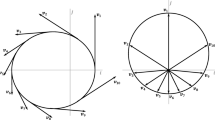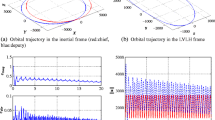Abstract
The orbital state of a satellite in a central force field can be uniquely described by its velocity hodograph, a circle, rather than the Keplerian conic. Also, its coordinate-frame rotation about the attracting center is definable, without singularity, by the four-parameter set of Euler parameters. A unified state model of orbital trajectory and attitude dynamics has previously been developed by use of state variables of the orbital velocity hodograph and Euler parameters. The dynamical constraint equations of this orbital state model are especially effective in advanced techniques of state estimation, used for orbit determination and prediction.
External observations of orbital vehicles, such as provided by optical and radar sensors of tracking systems, are transformable into corresponding velocity state maps, as presented in this paper. These transformations and the consequent state maps are essential for development of the orbit observation matrix used with the unified state matrix, in recursive estimators such as the Kalman filters.
Line-of-sight rays and range spheres (or hemispheres) of observations map conformally into orthogonal spherical surfaces in velocity space, as the result of the point-contact transformations. In bispherical coordinates, the field of observation maps for a ground-based tracking system site is shown to be a reduced (or degenerate) form of the general field of observation maps for a satellite-based tracking site.
These orbital state maps and transforms are directly useful in development of observation matrices for candidate observation sets, such as range only, angle only, or range plus range-rate tracking schemes. Also, surface coverage patterns can be generated for proposed new tracking systems, in mission analysis and system synthesis studies.
Similar content being viewed by others
Abbreviations
- A, E:
-
azimuth and elevation respectively, of a point referred to radar range coordinates (E, N, U) about a ground-based site
- B, D:
-
generator parameters of the line-of-sight maps in velocity space
- C, R:
-
parametric variables of orbital velocity state
- d :
-
displacement of the mapping field for the satellite-based site from the velocity space orgin (=one-half the displacement of site mapS′ from the origin)
- [E]:
-
transformation matrix of attitude rotation, with elements ɛ ij
- e 1,e 2,e 3,e 4 :
-
Euler parameters defining rotation of a coordinate set
- e 01,e 02,e 03,e 04 :
-
Euler parameters defining rotation of the orbital trajectory frame about the planetocentric origin
- F, G, H :
-
generator parameters of the range maps in velocity space
- G () :
-
center points for generator circles () of line-of-sight maps
- [H]:
-
measurement transformation from a given state
- h :
-
scalar range from site to a given observed point
- I,J,K,L,M :
-
typical range spheres about a satellite-based site (see Figure 7)
- La, Lo:
-
latitude and longitude respectively, of topocentric coordinates
- LH:
-
local horizon plane
- LP, IP:
-
launch point and impact point respectively, for an Earth-intersecting orbit
- m r, mv, mp :
-
the slope of a curve at a given point, for the position conic, velocity hodograph and observation-map respectively
- O :
-
velocity space origin
- P :
-
point in position space
- P(r) :
-
vector form of orbital conic in position space
- R E :
-
spherical Earth's radius
- R f1, Rf2 :
-
components of the orbital velocity state variable,\(\bar R\) in the instantaneous orbital plane
- r, v, a :
-
position, velocity and acceleration vectors respectively, of orbital motion
- S :
-
location of the satellite-based site in position space
- T():
-
transform operator between orbital and observation maps
- U :
-
local vertical coordinate, referred to the ground-based site
- u, w :
-
noise in the measurement and process state respectively
- V :
-
nadir point on the Earth's surface directly below the satellite-based site (see Figure 7)
- w :
-
radial displacement (from the\(C\upsilon _{{{e2} \mathord{\left/ {\vphantom {{e2} {\dot X}}} \right. \kern-\nulldelimiterspace} {\dot X}}} \)-axis) of a given field-point of observation, in the bispherical coordinates
- X,Y,Z :
-
Cartesian (inertial) components of position, referred to the planetocentric origin
- \(\dot X,\dot Y,\dot Z\) :
-
Cartesian components of velocity, referred to the velocity-space origin
- \(\ddot X,\ddot Y,\ddot Z\) :
-
Cartesian components of acceleration, referred to the acceleration-space origin
- x,y,z :
-
Cartesian components of position, referred to the ground-based site as origin
- x :
-
generalized state vector
- α,β:
-
generator parameters of the range maps in velocity space
- γ:
-
elevation angle, referred to the local horizon of a site
- Δ:
-
orbital altitude of a satellite-based site
- ɛ ij :
-
elements of the rotation matrix[E];i,j=1,2,3
- ζ,η:
-
bispherical coordinates (ζ=line-of-sight family, η=range maps)
- θ:
-
angle between the tangent to the orbital conic at a point and its normal, in the direction of flight (i.e., flight-path angle)
- λ:
-
angle of rotation from the axisX′ to the orbital position vectorr, in the instantaneous orbital plane
- μ:
-
planetary gravitational constant
- Φ:
-
state transition transformation
- ϕ:
-
true anomaly
- χ:
-
angle of rotation from the axisX′ to the perigee apsis
- ψ:
-
site azimuth angle of the observation line-of-sight
- Ω, ι, u|:
-
ordered set of Euler angles (X-axis to line-of-nodes, equatorial plane of orbital plane, line-of-nodes to given position vector, respectively)
- b :
-
ballistic
- e1,e2:
-
rotating polar components of orbital motion
- k, k=1:
-
time instancek, k+1 respectively
- LP, IP:
-
launch point, impact point respectively
- X, Y, Z :
-
Cartesian components of position, referred to the planetocentric origin
- \(\dot X,\dot Y,\dot Z\) :
-
Cartesian components of velocity, referred to the velocity-space origin
References
Altman, S. P. and Pistiner, J. S.: 1968, ‘Application of State Space Transformation Theory to Orbit Determination and Prediction’, AAS Paper No. 68-111, AAS/AIAA Astrodynamics Specialist Conference, Jackson, Wyoming, September 3–5.
Altman, S. P. and Pistiner, J. S.: 1970, ‘A New Generating Principle for Two-Fixed Center Orbits: Conic Solutions’,Proceedings of the XIXth International Astronautical Congress, Vol. 2, Astrodynamics and Astrionics, Pergamon Press, pp. 27–57.
Altman, S. P.: 1972, ‘A Unified State Model of Orbital Trajectory and Attitude Dynamics’,Celes. Mech. 6, 425–446.
Hamilton, Sir William Rowan: 1866, in C. J. Joly (ed.),Elements of Quaternions, Volumes I and II. Reprint by Chelsea Publishing Co., New York 1969.
Halberstam, H. and Ingram, R. E. (eds): 1967,The Mathematical Papers of Sir William Rowan Hamilton, Vol. III: Algebra, Cambridge University Press.
Kasner, E.: 1913, ‘Differential-Geometric Aspects of Dynamics’,American Mathematical Society Colloquium Series, Vol. 3.
Mobius, A. F.: 1887,Gesammelte Werke, Vol. 4, S. Hirzel, Leipzig, Reprint by Dr Martin Sandig oHG, Wiesbaden, 1967.
Zwikker, C.: 1963,The Advanced Geometry of Plane Curves and Their Applications, Dover Publications.
Moon, P. and Spencer, D. E.: 1961,Field Theory for Engineers, D. Van Nostrand, Princeton, New Jersey.
Moon, P. and Spencer, D. E.: 1971,Field Theory Handbook, Springer-Verlag, Berlin.
Kalman, R. E.: 1960, ‘A New Approach to Linear Filtering and Prediction Problems’, Transactions of the A.S.M.E.,Journal of Basic Engineering 82D, 35–45.
Sorenson, H. W.: 1966, ‘Kalman Filtering Techniques’, in C. T. Leondes (ed.),Advances in Control Systems, Vol. 3, Academic Press, New York.
Sinha, N. K. and Mukherjee, S. K.: 1974, ‘An Adaptive Scheme for Kalman Filtering’,IFAC Symposium on Stochastic Control, Budapest, Hungary, November 1974.
Author information
Authors and Affiliations
Rights and permissions
About this article
Cite this article
Altman, S.P. Velocity-space maps and transforms of tracking observations for orbital trajectory state analysis. Celestial Mechanics 11, 405–428 (1975). https://doi.org/10.1007/BF01650281
Received:
Revised:
Issue Date:
DOI: https://doi.org/10.1007/BF01650281




